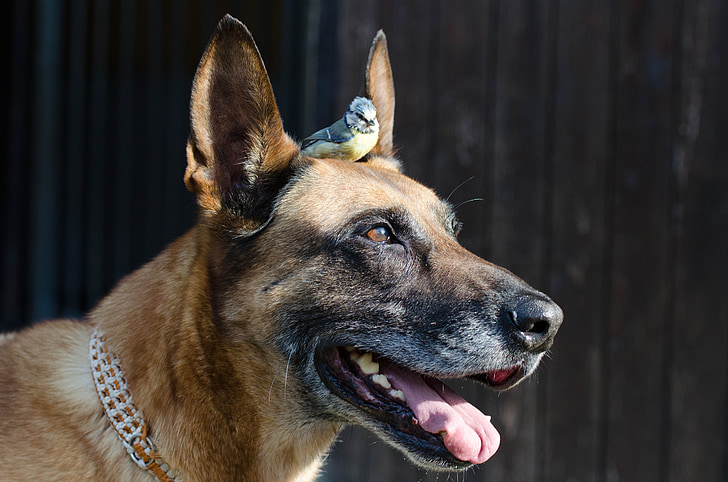Key Takeaways
-
Understanding your German Shepherd’s natural prey drive is crucial for safe bird interactions.
-
Introduce your German Shepherd to birds gradually, using controlled environments and positive reinforcement.
-
Recognizing your dog’s body language can help prevent aggressive behavior towards birds.
-
Training commands like ‘leave it’ and ‘stay’ are essential for managing your dog’s instincts around birds.
-
Creating a bird-safe space and secure yard can protect both your pet bird and your German Shepherd.
Meeting New Friends: How Your German Shepherd Views Birds
When your German Shepherd first encounters a bird, it’s a clash of instinct and curiosity. These dogs have a storied past, where their roles as herders and protectors required a strong prey drive. This drive doesn’t vanish in a domestic setting; it’s part of their DNA. But with the right approach, you can help your German Shepherd understand that the family parrot isn’t prey, but part of the pack.

“Adult brown Belgian malinois with black …” from www.pickpik.com and used with no modifications.
The German Shepherd’s Prey Drive: What Is It?
So, what exactly is prey drive? It’s a natural instinct that drives dogs to chase and capture small, fast-moving creatures. It’s why your German Shepherd might perk up at the sight of a bird. This isn’t bad behavior; it’s just your dog being a dog. However, we can guide this instinct to ensure it doesn’t lead to trouble, especially if you have pet birds at home.
Fostering a Calm Meeting: Techniques for Safe Introductions
Introducing your German Shepherd to a bird requires patience and a few tricks up your sleeve. First, always start in a controlled environment. This means having your dog on a leash and the bird in a cage or another safe space. Keep the first meeting short, sweet, and with plenty of treats on hand to reward calm behavior.
Most importantly, watch for signs of stress or aggression from either animal. If you see these, it’s time to separate them and try again later. Consistency and repetition are your best friends here; over time, your German Shepherd will learn that the bird is part of the family and not a snack on wings.
Positive Reinforcement: Rewarding Good Interactions
Positive reinforcement is the golden rule when it comes to training your German Shepherd to be bird-friendly. This means rewarding your dog for good behavior around birds, which can include anything from staying calm when a bird flutters by to obeying a command like ‘leave it’ when they’re too interested in your feathered friend.
-
Offer treats or praise immediately after your dog exhibits calm behavior around birds.
-
Use toys or playtime as a reward for ignoring birds during walks.
-
Be consistent with rewards to reinforce the desired behavior.
Remember, the goal is to make positive interactions with birds more rewarding than the thrill of the chase. Over time, your German Shepherd will associate birds with positive experiences, reducing their urge to see them as prey.
And don’t forget, timing is everything. The reward must come right after the good behavior, so your dog knows exactly what they’re being praised for. With patience and consistency, your German Shepherd will learn that being calm and collected around birds is the best way to earn your approval—and some tasty treats!
Creating a Safe Environment for Birds and Dogs
-
Never leave your German Shepherd unsupervised with pet birds, especially in the early stages of training.
-
Ensure your bird’s cage is sturdy and secure to prevent any accidents if your dog gets too curious.
-
Consider using baby gates or pet barriers to create designated bird-safe areas in your home.
Creating a bird-safe environment goes beyond training sessions. It’s about making your home a place where both your German Shepherd and your birds can coexist peacefully. This means taking practical steps to minimize risks and setting up spaces where each pet can feel secure.
For instance, place your bird’s cage in a high, inaccessible spot where your dog can’t reach. This not only keeps your bird safe but also helps your dog understand that the bird is off-limits. Additionally, give your bird time out of the cage in a separate room where your dog can’t enter. This allows your feathered friend to stretch their wings and enjoy some freedom without stress.
Another key aspect is to secure your yard. If you have an outdoor space, ensure it’s properly fenced so your German Shepherd can’t chase after wild birds. This not only protects local wildlife but also prevents your dog from developing bad habits that could translate to how they treat pet birds indoors.
Securing Your Yard: Preventive Measures
Securing your yard is about more than just putting up a fence. It’s about creating an environment where your German Shepherd can enjoy the outdoors without putting birds at risk. Start by removing any potential hazards that could harm birds, such as open water where they could drown or toxic plants they might ingest.
Then, focus on enrichment for your German Shepherd. A bored dog is more likely to chase birds, so provide plenty of toys and activities to keep them engaged. This can include puzzle feeders, agility equipment, or even a sandbox for digging. By keeping your dog’s mind and body busy, you’ll reduce their interest in chasing birds and ensure they’re happy and healthy in their outdoor space.
Safe Spaces: Giving Birds Their Sanctuary
Just as your German Shepherd needs a safe yard, your pet birds need a sanctuary of their own. This is a space where they can feel secure and comfortable, away from the curious nose of your dog. Whether it’s a specific room or a well-placed cage, your bird’s sanctuary should be a place where they can relax and be themselves.
Factors to Consider With Rescue German Shepherds
Rescue German Shepherds may come with their own set of challenges, especially when it comes to introducing them to birds. Their past experiences, which might include neglect or lack of socialization, can influence their behavior significantly. It’s essential to understand that these dogs may need extra time and patience to adjust to living with birds.
When you bring a rescue German Shepherd into your home, take the time to learn about their history. This information can be vital in understanding their reactions to birds and other animals. If possible, work with the rescue organization to get a sense of your dog’s previous environment and any behavioral issues they may have.
Most importantly, don’t rush the introduction process. Rescue dogs often need time to settle into their new home and build trust with their new family. Only once they feel secure in their environment should you begin the careful process of introducing them to your pet birds.
Socialization: How Past Experiences Shape Behavior
Socialization is key in shaping your German Shepherd’s behavior around birds. A dog that’s had positive experiences with a variety of animals from a young age is more likely to be calm and non-aggressive towards birds. On the other hand, a dog with limited socialization may react with fear or aggression when encountering new creatures.
For rescue dogs, it’s crucial to start socialization slowly. Begin with controlled exposure to birds from a distance, gradually decreasing the distance as your dog becomes more comfortable. Always monitor their body language and be ready to step back if they show signs of stress or aggression.
Remember, socialization isn’t just about exposure; it’s about creating positive associations. Pair each new experience with something your dog loves, like treats or praise, to help them understand that birds are friends, not foes.
FAQ
When it comes to German Shepherds and birds, many owners have questions. Here are some answers to the most common queries:
Are there specific training methods for rescue dogs?
Rescue dogs, including German Shepherds, often benefit from a patient and gradual approach to training. It’s important to build trust first, as many rescue dogs may have had negative experiences in the past. Start with basic obedience training to establish communication and gradually introduce new concepts and socialization experiences.
How do I know if my German Shepherd has a high prey drive?
You can tell if your German Shepherd has a high prey drive by observing their reaction to fast-moving objects or animals. Does your dog fixate, stalk, or chase after birds, squirrels, or even leaves blowing in the wind? These are signs of a strong prey drive. Also, consider their level of focus and intensity during these moments; a dog with a high prey drive may become so fixated that they ignore your calls or commands.
Moreover, pay attention to their behavior during walks or in the backyard. If your German Shepherd is consistently trying to pursue wildlife or is overly excited by the presence of birds, this indicates a natural inclination to follow their prey drive instincts.
Example: If you notice that your German Shepherd is always on high alert, ears perked and body tense, whenever a bird flies by, it’s likely they have a high prey drive.
Understanding your dog’s prey drive is the first step in managing their behavior around birds and ensuring a harmonious household for all your pets.
Can German Shepherds live peacefully with pet birds?
-
Yes, with proper training and socialization, German Shepherds can live peacefully with pet birds.
-
It’s important to introduce them gradually and under controlled conditions.
-
Use positive reinforcement to reward non-aggressive behavior.
-
Create separate safe spaces for each pet to ensure they can coexist without stress.
Many German Shepherd owners successfully maintain a peaceful home with both dogs and birds. It requires a commitment to training and understanding the needs of each animal. By fostering positive interactions and respecting each pet’s space, you can create a harmonious environment where both your German Shepherd and your bird feel comfortable and safe.
It’s essential to remember that each dog is an individual, and some may require more training and patience than others. The key is to never force interactions and to always supervise any time your pets are together.
Keep in mind that the safety of all pets is paramount. Even with the best training, accidents can happen, so it’s crucial to always be vigilant and proactive in managing your pets’ environment. Learn more about introducing birds to dogs to ensure a harmonious household.
What should I do if my German Shepherd chases birds on walks?
If your German Shepherd chases birds on walks, it’s important to redirect their focus. Teach commands like ‘leave it’ or ‘focus’ to gain their attention during these moments. Keep a leash on your dog to prevent them from taking off after birds, and practice these commands regularly in environments where distractions are controlled.
Also, provide plenty of mental and physical stimulation through toys and exercise to reduce their urge to chase. If the behavior persists, consider consulting a professional dog trainer for additional strategies tailored to your dog’s needs.
Remember, consistency is key. Consistently training and rewarding your dog for ignoring birds will help them learn the appropriate behavior during walks.
How long does it usually take to train a German Shepherd to be calm around birds?
The time it takes to train a German Shepherd to be calm around birds varies based on the individual dog, their age, temperament, and past experiences. For some dogs, it may take a few weeks of consistent training, while for others, it may take several months or more.
It’s important to set realistic expectations and understand that training is a process. Patience and consistency from you, as the owner, will be crucial to your dog’s success. Regular, positive training sessions will gradually teach your German Shepherd the correct behavior around birds.


